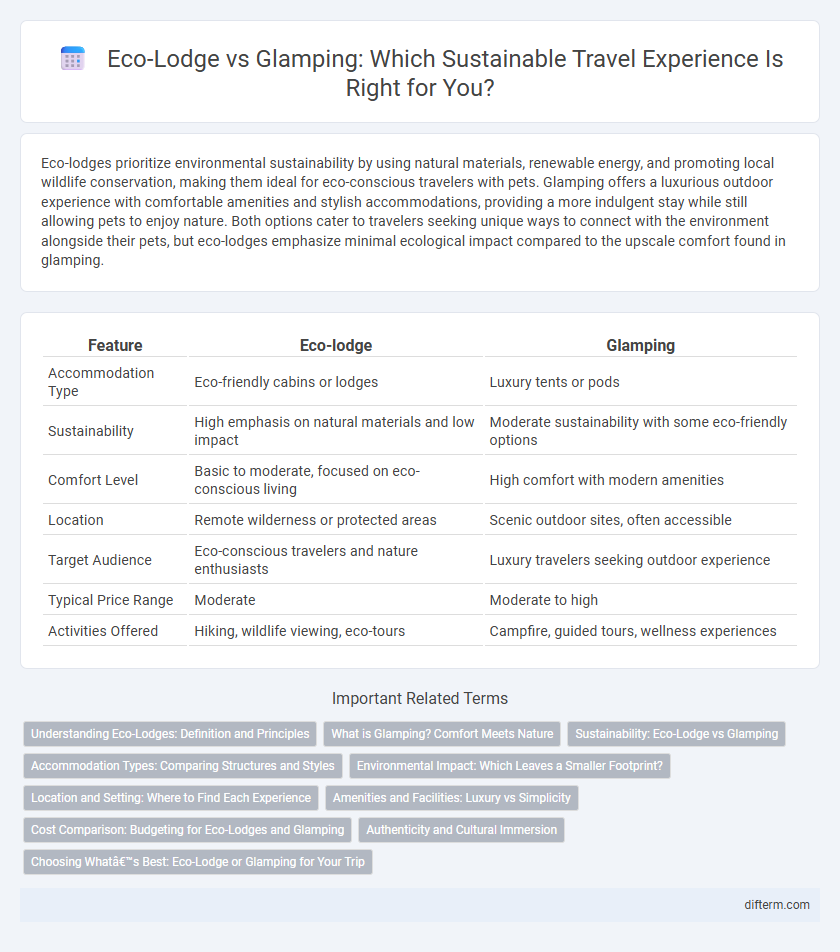Eco-lodges prioritize environmental sustainability by using natural materials, renewable energy, and promoting local wildlife conservation, making them ideal for eco-conscious travelers with pets. Glamping offers a luxurious outdoor experience with comfortable amenities and stylish accommodations, providing a more indulgent stay while still allowing pets to enjoy nature. Both options cater to travelers seeking unique ways to connect with the environment alongside their pets, but eco-lodges emphasize minimal ecological impact compared to the upscale comfort found in glamping.
Table of Comparison
| Feature | Eco-lodge | Glamping |
|---|---|---|
| Accommodation Type | Eco-friendly cabins or lodges | Luxury tents or pods |
| Sustainability | High emphasis on natural materials and low impact | Moderate sustainability with some eco-friendly options |
| Comfort Level | Basic to moderate, focused on eco-conscious living | High comfort with modern amenities |
| Location | Remote wilderness or protected areas | Scenic outdoor sites, often accessible |
| Target Audience | Eco-conscious travelers and nature enthusiasts | Luxury travelers seeking outdoor experience |
| Typical Price Range | Moderate | Moderate to high |
| Activities Offered | Hiking, wildlife viewing, eco-tours | Campfire, guided tours, wellness experiences |
Understanding Eco-Lodges: Definition and Principles
Eco-lodges are sustainable accommodations designed to minimize environmental impact through energy-efficient systems, waste reduction, and the use of locally sourced materials. Rooted in principles of conservation and community engagement, eco-lodges often support local economies and protect natural habitats. These lodges emphasize immersive nature experiences while promoting responsible tourism and environmental education.
What is Glamping? Comfort Meets Nature
Glamping, a fusion of glamour and camping, offers luxurious accommodations amid natural settings, blending comfort with outdoor adventure. Unlike traditional camping, glamping includes amenities such as comfortable beds, electricity, and private bathrooms, providing a hassle-free experience in nature. This eco-friendly alternative appeals to travelers seeking immersive wildlife encounters without sacrificing modern conveniences.
Sustainability: Eco-Lodge vs Glamping
Eco-lodges prioritize sustainability through eco-friendly construction materials, renewable energy use, and waste reduction practices, minimizing environmental impact in remote natural settings. Glamping offers a luxurious camping experience often using tents or cabins with eco-conscious amenities but generally has a larger carbon footprint due to higher resource consumption and energy use. Sustainable travelers seeking low-impact accommodation should consider eco-lodges as a more responsible alternative to glamping for preserving natural habitats.
Accommodation Types: Comparing Structures and Styles
Eco-lodges emphasize sustainable architecture using natural materials such as bamboo, wood, and stone, blending seamlessly with the environment to minimize ecological impact. Glamping structures often feature luxury tents, yurts, or treehouses equipped with modern amenities like comfortable bedding, electricity, and private bathrooms. While eco-lodges prioritize eco-friendly design and minimalistic living, glamping combines the rustic outdoor experience with upscale comfort and style.
Environmental Impact: Which Leaves a Smaller Footprint?
Eco-lodges typically have a smaller environmental footprint due to their use of sustainable materials, renewable energy sources, and waste reduction practices designed to minimize ecosystem disruption. In contrast, glamping often involves temporary structures that may require more resources for setup and maintenance, though some luxury glamping sites adopt eco-friendly measures to reduce impact. Evaluating environmental impact depends on location, management practices, and guest behaviors, but overall, eco-lodges are generally more aligned with conservation principles and resource efficiency.
Location and Setting: Where to Find Each Experience
Eco-lodges are typically found in remote, natural settings such as rainforests, mountains, and coastal reserves, designed to blend seamlessly with the environment for an immersive sustainable experience. Glamping sites often appear near popular tourist destinations like national parks, beaches, and scenic countryside, offering luxury accommodations with easy access to adventure and local attractions. Both options emphasize unique landscapes, but eco-lodges prioritize ecological preservation while glamping focuses on comfort without sacrificing the outdoor atmosphere.
Amenities and Facilities: Luxury vs Simplicity
Eco-lodges emphasize sustainable luxury with amenities such as solar-powered electricity, organic toiletries, and locally sourced gourmet meals, providing a blend of comfort and environmental responsibility. Glamping offers simplicity paired with stylish features like comfortable bedding, private fire pits, and basic cooking facilities that enhance the outdoor experience without excessive luxury. Both options cater to travelers seeking unique accommodations but differ in the level of sophistication and eco-conscious amenities provided.
Cost Comparison: Budgeting for Eco-Lodges and Glamping
Eco-lodges typically offer more affordable rates, ranging from $50 to $150 per night, making them ideal for budget-conscious travelers seeking sustainable accommodations. Glamping tends to be pricier, with costs between $100 and $300 per night, reflecting luxury amenities such as comfortable beds, electricity, and private bathrooms. Budget planning for eco-lodges emphasizes simplicity and eco-friendly features, while glamping budgets account for upscale comfort and unique experiences.
Authenticity and Cultural Immersion
Eco-lodges offer an authentic cultural immersion by integrating local architecture, traditions, and sustainable practices that support indigenous communities. Glamping provides comfort and luxury in nature, but often prioritizes aesthetics over genuine cultural experiences. Travelers seeking deep connection with local heritage and environmental stewardship find eco-lodges to be the more immersive choice.
Choosing What’s Best: Eco-Lodge or Glamping for Your Trip
Eco-lodges offer sustainable accommodations built with natural materials and designed to minimize environmental impact, ideal for travelers seeking an immersive nature experience with a lower carbon footprint. Glamping combines the luxury of hotel amenities with outdoor camping, appealing to those who want comfort and convenience without sacrificing the connection to nature. Choosing between an eco-lodge and glamping depends on priorities such as sustainability, comfort level, and the type of immersive experience desired during your trip.
Eco-lodge vs Glamping Infographic

 difterm.com
difterm.com